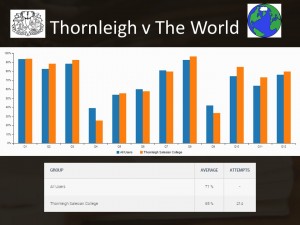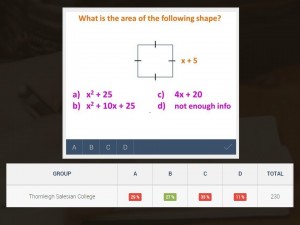Each week we set all our Year 11 Higher GCSE students a GCSE Essential Skills Quiz from my Diagnostic Questions website. These quizzes are completely free and are designed to test the content that appears on the majority of GCSE higher maths papers. These are the kind of questions that students should get right, but which time and time again cost our Year 11s the valuable marks that prevent them getting the grade they want.
We set our quizzes on a Monday, the students complete them for Friday, and then I sit down with a Mellow Birds coffee and a yoghurt (it is the weekend, after all) to analyse the results. I try to find one key insight, and then share it with staff in our weekly Departmental Meeting in a 5 minute slot called “Insight of the Week”.
Why not join in too by setting these quizzes to your Year 11s? The more the merrier!
Quiz 2 is below, followed by the key insight from this week.
How our students performed compared to the rest of the world:
We had big issues with properties of kites and rearranging formula, but the question that caused our students the most problems was the following classic fusing together algebra and geometry:
Only 27% of our Year 11 students got this question correct, with A and C luring in over half of them.
Now, expanding double brackets is an essential skill, and we would hope our students would have more success in this area. But I suspect it was the added context of the question that caught our lot out. This becomes more apparent was we read some of their explanations:
Incorrect Answer A (29% of our students chose this)
The classic incorrect way to multiply out squared brackets. I think I’ve told my Year 11s approximately 6,373 times to write the brackets out next to each other and either use FOIL or the smiley-face method. 5 of my students went for this option, so it seems I am going to have to try something else.
“X * X = X squared 5*5 = 25”
“All sides in a square are equal x * x = x2 5 * 5 = 25”
Incorrect Answer C (33% of our students chose this)
Our most popular incorrect answer, catching the eye of 1 in 3 of our Year 11s. This is a completely different misconception to the one above. Here, students are displaying algebraic proficiency, but are muddling up area with perimeter. Would they also do this in a non-algebraic context? We will need to test our Year 11s to find that out.
“I think the answer is C because it is a square so all the sides are equal. so to work out the formula of the area you just times x+5 by 4”
“As it is a square and all sides are of equal length so: 4 (×+5)=4×+20”
Incorrect Answer D (11% of our students chose this)
I find this answer fascinating, but when you think about it, it makes total sense. Students, for years, have been used to working out areas that have actual number answers, and also solving equations that have actual number answers. Now they are asked to find an area, and yet they do not know the value of x. We need to ensure our Year 11s are comfortable leaving answers to questions in terms of x, otherwise they could come a cropper!
“We need to know the length and width, but we don’t know the value of x”
“its D because you don’t know the value of x”
One of my motivations for developing Diagnostic Questions was so that students all around the world could learn from each other. When your students finish a quiz, please encourage them to review their answers, reading through other students’ explanations, until they find the magic one that makes sense to them. So, what are our Year 11 students’ favourite correct explanations to help them resolve their own misconceptions?
“(x+5)^2 = x^2 + 10x +25 x * x = x^2 5 * 5 = 25 5 * 1 = 5 *2 = 10x”
“(x + 5)(x + 5) x times x is x squared 5 times x equals 5x 5 times x equals 5x again 5 times 5 equals 25 5x plus 5x =10x”
Tackling the Misconception in Class
So, when we discussed this insight in our Departmental Meeting, what ideas did we come up with for resolving the misconceptions in lessons this coming week with our students:
- Getting students to mark on the base and height of the square
- Ensuring the write out the formula for area
- Putting brackets around the (x + 5). This led on to a big discussion about how it could well be good practise to encourage students to put brackets around all algebraic expressions when they appear in a geometrical context. This will obviously help with multiplying, but may also be beneficial when faced with things like: (x + 4) – (x – 2), and the classic missing of the double-negative.
- Similar to last week, substituting values in for x and seeing which of the expressions give the same answer
Please add any extra ideas in the Comments section below!
The series of GCSE Essential Skills Quizzes are available here and will always be completely free.
Quiz 3 is available here
I hope this quizzes will prove useful to help your students develop the essential skills necessary for success at GCSE, and aid your teachers gain a deeper understanding of how your students learn.


